FLAT PANEL OFF-CAMERA FLASH
Zenon MagneFlash 57Plus
-- A Brilliant Idea
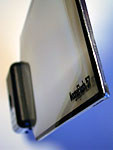 By MIKE PASINI
By MIKE PASINIEditor
The Imaging Resource Digital Photography Newsletter
Review Date: January 2004
We confess. Our disdain for the flash units built into every digicam (and proliferating like a virus into some dSLRS even) is so strong that we think of them as inherently defective.
We've written around this subject for a long time. We told you how to use natural light with shutter priority mode, reviewed a terrific soft box for studio shots and described our elaborate off-camera flash set-up. But we have long wished for a simple off-camera flash solution we could recommend.
A few months ago, newsletter subscriber Bill Stocks put us on to Peter Louden's Zenon MagneFlash. Peter sent us a review unit and we've been playing with it for weeks now.
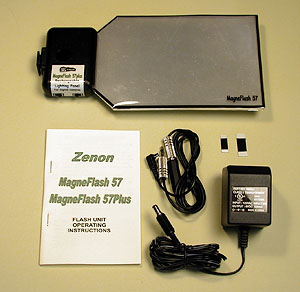 |
| Package Contents: The MagneFalsh (t), the manual (l), PC synch cord (m), two IR filters (the removable white ends cover the adhesive) and the adapter (r) |
The Zenon MagneFlash line is nearly, nearly, nearly the simple solution we've wanted. Our only reservation, really, is that it isn't designed to light up a room of family and friends at a party. But it's wonderful for macro shots and portraits and it plays very, very well with all sorts of digicams. So let's take a look.
THE MAGNEFLASH LINE
There are several MagneFlashes: the 57, the 57Plus and the DL.
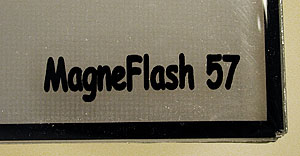 |
| Panel Detail |
The MagneFlash 57 is the base unit. A compact black ABS case holds the rechargeable NiMH batteries and the lamp is attached to a unique 5x7-inch reflective panel.
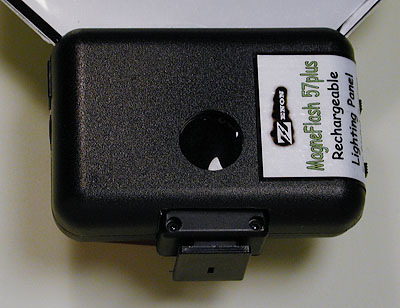 |
| The Front: Note the large infrared sensor in the middle. |
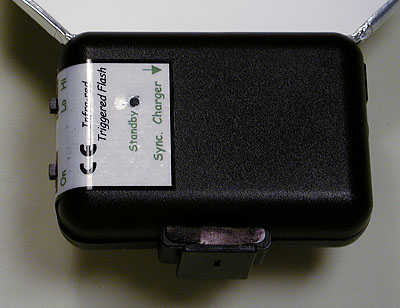 |
| The Back. The 'Standby' LED on the label lights red when ready. |
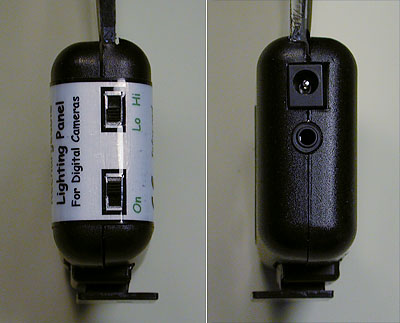 |
| The Sides: The Lo/Hi power switch sits above the On/Off switch (r) while the power adapter socket sit above the PC synch socket on the Plus model (l). |
On the left side of the case is a power switch and a Hi/Lo output switch. The other side has the power adapter socket and, on the 57Plus model, a PC synch socket. The rear of the unit has a small LED standby indicator. The bottom of the case has a hot shoe mount with no electronic leads. Instead, the unit is triggered by a built-in infrared sensor on the front of the case. You don't need any cables.
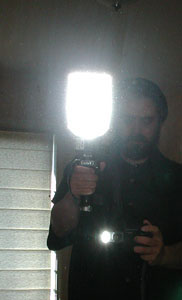 |
| The Panel in Action. MagneFlash mounted on Vivitar pistol grip, synched to on-board flash covered with IR filter held by unidentified intern at a recent Roman shade festival |
The MagneFlash DL, currently in testing, features a trigger delay to work with digicams that always use a pre-flash (like most Olympus and Minolta models).
FIT & FINISH
We were a little disappointed with the fit and finish of the MagneFlash. It seems built on a kitchen table assembly line rahter than something produced by the robots at Mitsubishi.
But we were more than a little impressed with the design of the unit. And that carried over to our appreciation for its performance. It may be a little funky, but it knows what to do with what it has.
THE PANEL
And what it has is that unique 5x7 panel with an intimate relationship to the lamp hidden in the small black case.
We assumed the unit worked something like a big bounce flash. You can't see the lamp. So no red eye. But the reflector is a bit unusual.
When we asked Peter about it, he replied, "You are correct, the flash lamp is in the black case but it is attached to the edge of the panel. Reflectors on all sides of the lamp catch all the light and feed it into the panel, which acts like a fiber optic. The refracted light is spread over the panel.
"Behind the panel is a metal reflector which gathers any light going out the back. In front of the panel are lenses/polarizers which channel the light forward into an ideal shaped 'lobe.'"
Rarely do we ask a question and get such a satisfying answer. Who is this guy, we wondered. So we asked.
THE DESIGNER
Peter, it turns out, was the technical director of Bowens studio lighting originally sold in the U.S. by Bogen in Newark and Calumet in Chicago (among other countries). Many of the studio lighting monoblocks and powerpacks still being sold were designed by Peter and his teams. He also made special units for Calumet. Just for fun, he was the technical director for Cambo in Holland where his team designed the Ultima, a large format, full movement advanced camera for professional digital backs. He also was involved in designing studio equipment for Zone VI in Vermont, Connecticut and elsewhere.
He started his own company five years ago to produce the first lighting kit specifically designed for digital cameras. It received good reviews in magazines like the British Journal of Photography and What Camera. He then designed and supplied electronic information panels (the Framer) to UK businesses and local councils.
It was not until he produced the Dual Force Pro power packs three years ago that he began exporting equipment to the U.S. The MagneFlash is the latest design, but by no means the last he tells us, to be developed and produced by Louden Photographic under the Zenon banner in England.
USING THE MAGNEFLASH
The trouble with unique devices is that the user (namely ourselves) is often befuddled. How exactly do you use the thing?
A conveniently small manual accompanies the flash (along with a charger and two very small IR filters designed to stick to your digicam's flash). We read it but we thought we'd ask Peter for a little more guidance. We weren't disappointed.
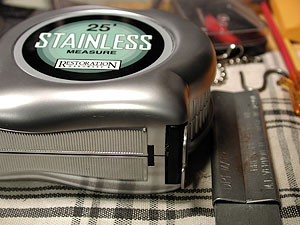 |
| Under Construction Macro shot of reflective tool |
"The panel will give around f8.0+ at 1.5 feet using ISO 200," he said. "This is over most of the panel's surface as opposed to the point, on-axis measurement taken with a conventional flash. The Lo setting on the Plus gives about one stop down from this. When holding the MagneFlash near the camera and close to the subject, the Lo power setting gives nearer the correct exposure. Where you have control of the aperture and have to stop down to get a good field of focus, the Hi setting would be preferable. Obviously when using the unit further away, the Hi setting is the norm, though the 57Plus is not designed for distance shots such as large group photos etc. (though it is good for head and shoulders).
 |
| Daylight Fill. Hi setting (l), Lo setting (m) and off (r) comparison shows excellent color balance |
"For daylight fill-in, the unit is better than most since its color temperature and flash characteristics match daylight conditions better than conventional computerized flash. For example, very good results can be obtained for a portraiture shot with a daylight backlight and a single MagneFlash to the front (slightly to one side and above nose level). In this way, high-key lighting can be obtained whereas without much daylight, the MagneFlash is designed for low-key portraiture.
"The 57 or 57Plus also works very well as augmentation to studio flash. Customers who already have the Zenon ADF mini-studio kits use the MagneFlash as a third or fourth light source with good results. See http://www.nigelburkin.co.uk for one example.
"As a guide, the area of coverage at 1.5 feet is about 1.5 feet by 1 foot. At the normal distance for an adult head-and-shoulder shot, the area of coverage is greater than the distance between the top of the head to the shoulders."
OUR TESTS
Much as we love it when we can get someone else to write our reviews, we feel somewhat honor-bound to actually use the thing ourselves and see what happens.
We charged the unit overnight using the supplied adapter, even though it only takes six hours for a full charge. It turns out that one charge is good for a lot of flashes, roughly 250 per charge. But once the 1,000 charge cycles are used up, you can't replace the batteries yourself.
Two dark IR filters are supplied with the MagneFlash, a small one and a large one. We applied one of the filters over the flash on our Average digicam. The two filters were all it took to fit several various digicams lying around here. But you could no doubt make your own from some old exposed slide film, too.
We set the flash to always fire, so it would trigger the MagneFlash. And we mounted the charged MagneFlash on an old Vivitar pistol grip we really like. You can buy inexpensive pistol grips anywhere.
We set our Average digicam to ISO 200 and its aperture to f8. We really didn't bother with the shutter speed, varying it according to how much of the background was important to us.
As we shot, we noticed the internal flash was working pretty hard, requiring a long recycling time. Setting it to a lower power is probably a bright idea, since that's enough to trigger the MagneFlash without draining the battery.
The IR filter for the camera flash was pretty sticky. Repeated removal and reattachment isn't something we tested, but we didn't feel it was entirely debugged. You don't have to block the onboard flash, but it's a good idea. Unfortunately, it isn't always a good idea. Too bad there isn't a 3M Post-It adhesive for filters.
RESULTS
Briefly, our experience was that the unit was remarkably adept at lighting macro shots and very handy for daylight fill (especially because of its 5600-degree Kelvin color temperature). We found the lighting a little more harsh than ordinary bounce flash for larger scenes.
But we also found it a pleasure to use. That was partly because we mounted it on our old Vivitar pistol grip, making it easy to hold. But it was also because it was easy to get a feel for the lightweight MagneFlash. And since it was untethered, we were able to put it anywhere we could reach.
If you haven't used off-camera flash before, you might not appreciate that remark. Just think of being able to tell the sun exactly where it should shine. That's what the MagneFlash does for you.
PRICE
Here's the product list (all prices include shipping) in a nutshell:
- MagneFlash 57 Kit 1: MagneFlash 57, charger, IR filters, instructions for $102
- MagneFlash 57 Kit 2: Two MagneFlash 57s, charger, IR filters, instructions for $166
- MagneFlash 57Plus Kit 3: One MagneFlash 57Plus (with additional synch socket, synch lead and Hi/Lo power switch), charger, IR filters, instructions for $134
- MagneFlash 57 & 57Plus Kit 4: One MagneFlash 57, One MagneFlash 57Plus, Charger, IR filters, instructions for $198
CONCLUSION
We admit to having an aversion to using flash for close-ups. Products or people, once we get close, we avoid flash.
But the MagneFlash provides well-behaved flash for macro shots of even highly reflective objects and knows how to flatter portraits. As a sort of untethered bounce flash on steroids, it easily eliminates the possibility of red eye. And packing 250 shots per charge, it's ready even when you aren't.
The proof is in the pictures and the MagneFlash lets us take pictures we were afraid of shooting. It isn't a solution for all your flash shots, but for close-up product shots and portraits, it's the least expensive professional approach we've seen.